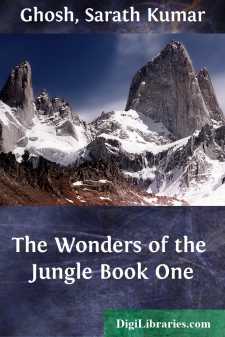Categories
- Antiques & Collectibles 13
- Architecture 36
- Art 48
- Bibles 22
- Biography & Autobiography 813
- Body, Mind & Spirit 142
- Business & Economics 28
- Children's Books 17
- Children's Fiction 14
- Computers 4
- Cooking 94
- Crafts & Hobbies 4
- Drama 346
- Education 46
- Family & Relationships 57
- Fiction 11829
- Games 19
- Gardening 17
- Health & Fitness 34
- History 1377
- House & Home 1
- Humor 147
- Juvenile Fiction 1873
- Juvenile Nonfiction 202
- Language Arts & Disciplines 88
- Law 16
- Literary Collections 686
- Literary Criticism 179
- Mathematics 13
- Medical 41
- Music 40
- Nature 179
- Non-Classifiable 1768
- Performing Arts 7
- Periodicals 1453
- Philosophy 64
- Photography 2
- Poetry 896
- Political Science 203
- Psychology 42
- Reference 154
- Religion 513
- Science 126
- Self-Help 84
- Social Science 81
- Sports & Recreation 34
- Study Aids 3
- Technology & Engineering 59
- Transportation 23
- Travel 463
- True Crime 29
The Wonders of the Jungle Book One
Categories:
Description:
Excerpt
PREFACE
One of the great thinkers of the world has said that all the sciences are embodied in natural history. Hence natural history should be taught to a child from an early age.
Perhaps the best method of teaching it is to set forth the characteristics of animals in the form of a narrative. Then the child reads the narrative with pleasure and almost as a story, not as a tedious "lesson."
I have followed that method in the Wonders of the Jungle. The present work (Book One) is intended to be a supplementary reader for the earlier grades in grammar schools. If it be found useful, I shall write one or two more books in progressive order for the use of higher grades.
In Book One I have depicted only such wild animals as appeal to the interest of young children, and even to their sympathy and love. In subsequent books I shall describe the animals that prey upon others. As those animals are not lovable, it would be better for the child to read about them a year or two later. But even to those animals I shall be just, and shall depict their good qualities as well as their preying habits. How many people know that the very worst animal, the tiger, is a better husband and father than many men? Or that the ferocity of the tigress is prompted entirely by her maternal instinct—and that in every case of unusual ferocity yet recorded it was afterward found that there was a helpless cub somewhere near? Hence in subsequent books I shall enter more fully into the causes of animal instincts and characteristics—their loves and their hates and their fears.
Regarding the scheme of Book One, the animals are described in their daily life, and the main scientific facts and principles concerning each animal are woven into the narrative as a part of that daily life. But while teaching science to the child in that pleasant form, a few other purposes have also been kept in view:—
1. To cultivate the child's imagination. True imagination is the ability to visualize mentally the realities of life, not what is unreal—for which it is so often mistaken. Hence in this book the child is helped to visualize the animals in their actual haunts, and to see each incident as it actually happens.
2. To cultivate the child's reasoning faculty. The child is encouraged at every step to think and to reason why the animal does certain things; e.g. why the elephant does not drink directly with its mouth, but has to squirt the water into it with the trunk.
3. To teach a moral from the study of animals. The whole of Creation is one immense and beautiful pattern: so the child may well be trained to see the pattern in this also. And as a practical benefit from the study of animals, the child may learn thereby the value of certain qualities, such as obedience, discipline, and good citizenship—e.g. as in the remarkable case of the elephant, the buffalo, and the flamingo, as described in the text. In this regard I have kept in mind the very useful suggestions formulated a few years ago by the Moral Education League of Great Britain, under the patronage of Queen Mary, five of whose children at that time ranged in age from seven to fifteen....



